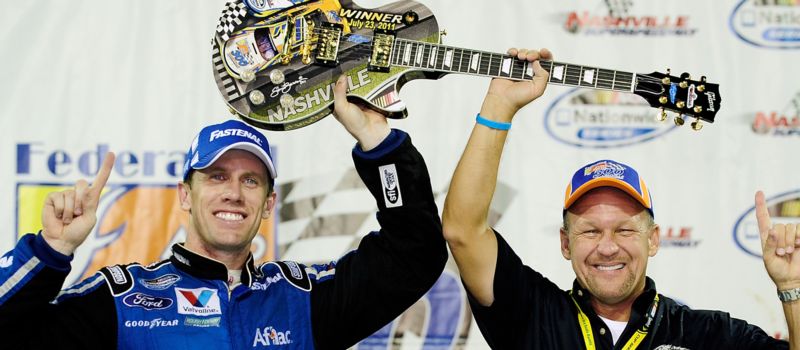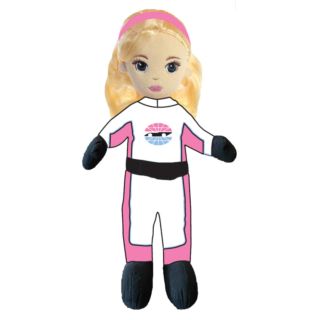To be a NASCAR legend, you typically need to be a top-notch driver, a master in the pit box, or a visionary team leader.
Sam Bass charted his path to stardom in another way, using colors, creativity and a passion for racing to design unforgettable car paint schemes, souvenir program covers and race trophies across decades.
The legendary artist, who died in February 2019 at age 57 after a courageous fight against kidney failure, became a fixture at Nashville Superspeedway when NASCAR first brought top-level racing to the Middle Tennessee track in 2001.
Sam helped design the famous Gibson guitars that Nashville champions received in Victory Lane and also created scores of memorable souvenir program covers that collectors still covet today.
With NASCAR’s return to Nashville Superspeedway, Sam‘s legacy remains firmly entrenched at the track, with tributes in the Infield Media Center and a Gibson guitar still a part of the Victory Lane tradition for Nashville’s race winners.
"Sam would be honored, and our family is proud, to have his name still associated with Nashville Superspeedway," said Denise Bass, Sam‘s wife of more than 37 years. “Sam was a people person and a great storyteller. He loved sharing the memorable experience of presenting the Nashville guitar trophy to each winner-and the fans remember.”
****
Sam‘s journey began in Hopewell, Virginia (about 20 miles south of Richmond) where he was born in November 1961.
It didn‘t take long for the love of his life to enter his world, as he met Denise when they were both in the seventh grade. They married in November 1981 and built a family. Today their daughter is 20 and son is 17.
Other than his family, Sam had two overriding passions — art and music.
Raised on country music, Sam was the lead guitarist for a band during his junior high and high school days. While art ultimately won out as a career choice, Sam continued to make music an important part of his life.
“He was always happy with his decision, but motivated to bring all of his interests together to reflect in his work -NASCAR, music, pop culture, nostalgia,” Denise remembers. “That is what made his compositions so unique.”
It didn‘t take long for Sam‘s artistic talents to catch the eyes of the racing world.
Soon, Sam was designing programs and trophies for nearby tracks such as Richmond International Raceway and Charlotte Motor Speedway as well as paint schemes for champion drivers, including Bobby Allison, Dale Earnhardt, Harry Gant, Tony Stewart and Rusty Wallace.
Two of his all-time favorite schemes are certainly well-known to NASCAR fans:
• The famed Rainbow Warrior car for Jeff Gordon who visited Victory Lane countless times with the colorful No. 24 Chevrolet as he dominated racing in the 1990s.
•A design nicknamed “Flashpoint” —a yellow and orange combination that Dale Earnhardt Jr. sported during one of his final full-time seasons.
“He wanted to influence the look of the sport as much as he wanted to capture its feel and history,” Denise said. “Paint schemes became a dominant part of his portfolio and produced the looks for generations of drivers as one crossed over to the next.”
****
By the time America‘s best drivers reached Nashville Superspeedway in 2001, Bass was already the first “Officially Licensed Artist of NASCAR.”
An earlier tour of the Gibson Guitars plant in Nashville led to several friendships the family maintains to this today. His association with Gibson also led him to create limited edition guitars featuring Dale Earnhardt, Dale Earnhardt Jr. and Richard Petty and also made him a natural choice to help design the Superspeedway‘s signature trophy and souvenir program covers.
“The Nashville guitar trophy became one of the most sought-after trophies on the Truck and Xfinity circuits,” Denise said. “The limited-edition driver guitars and especially the Nashville guitars paved the way for NASCAR banquet trophies and Daytona pre-race presentations. Having designed hundreds of guitars during his career, Sam’s desire was to create one that provided a broader canvas.”
****
Through these successes, Sam‘s life was not without challenges. At age 27, Sam was diagnosed with Type-1 diabetes, which eventually led to his fatal illness. Sam was on the donor list to receive a kidney transplant when he died and he spent much time and effort on raising awareness of kidney disease and diabetes. When he passed, the tributes came pouring in from the racing community.
“There‘s not many people that you meet in your life that are so happy to see you every time they see you, and he was that way,” recalled Dale Earnhardt Jr. “He set such a great example for all of us on how to treat people and how to maintain relationships. He just seemed so grateful for everything that ever happened to him. I hope that he‘s celebrated because he meant a lot to this sport.”
NASCAR also released a heartfelt statement: “Though he may have never turned a lap or a wrench, few captured the essence of our sport through his work more than Sam Bass. He was a consistent presence in the NASCAR garage, and his ever-present smile and endearing personality welcomed all. Though we have lost a member of the NASCAR family, his legend will continue in his art —all of which illustrated the greatness of our sport and the talent of a true friend.”
****
Recognizing and celebrating the past while pointing toward the future has been a key emphasis of Nashville Superspeedway President Erik Moses since he took the reins of the venue last summer.
“One of our priorities since beginning the work of revitalizing the Nashville Superspeedway has been to determine how to appropriately honor Sam Bass‘ memory and his influence on the sport,” Moses said. “As Denise and I continued to discuss Sam‘s legacy and what our track meant to him, it became clear that the tribute had to be permanent and not simply a one-off recognition. We look forward to presenting that tribute to our fans at the Superspeedway for years to come.”
On Saturday, June 19, Sam’s son presented Moses with a custom guitar featuring Sam’s logo that will be permanently displayed in the Superspeedway’s Media Center.
“Those who were there then have pressed for the tradition to continue in some way and they have shared the history of it, through social media, with a new generation of fans eagerly awaiting Nashville’s return to NASCAR racing through its inaugural Cup event,” Denise said.
“Working with Erik and the Superspeedway team these last several months and looking back on Sam’s career and accomplishments has brought a lot of wonderful memories to the forefront for our family. We are sincerely grateful to them for their thoughtfulness and appreciation of the impact and talents Sam had and gave completely to the sport he loved so much.
“I believe it’s natural for an artist to have so many creative ideas in his or her mind that it‘s impossible to execute them all in one lifetime.
“I believe they all leave something on the drawing table at the end. I would like to think that Sam left a concept that would have highlighted this inaugural event while reflecting the rich history of the past.”
While Nashville Superspeedway‘s Victory Lane gatherings will miss Sam‘s joyous presence, his legacy will be ever present at the track.




